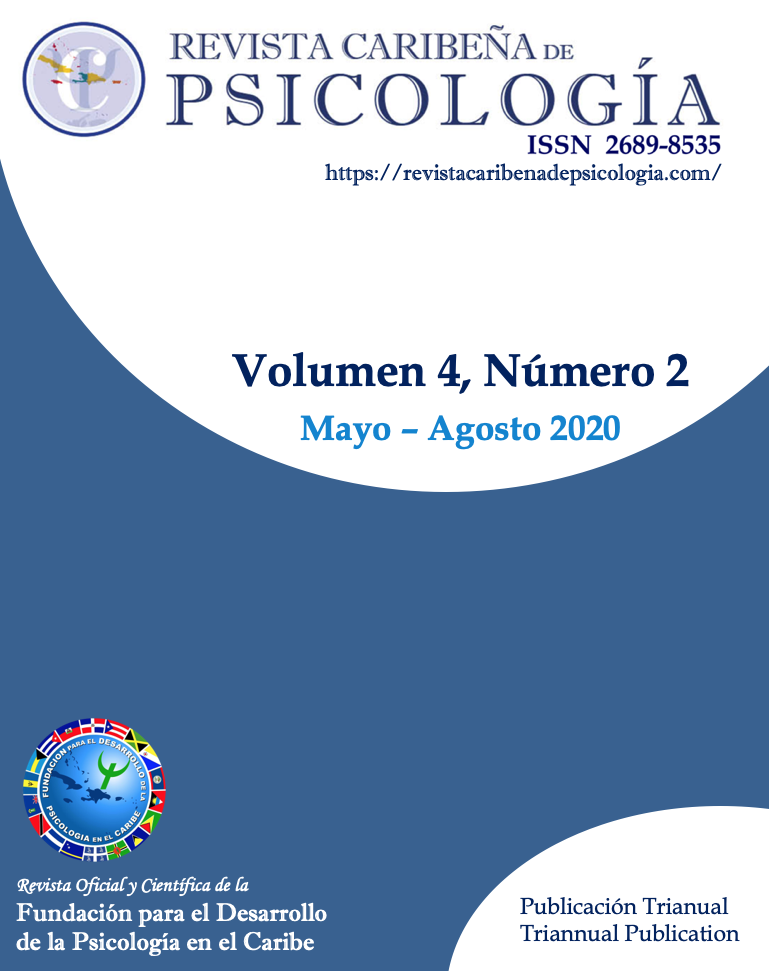Conditioned Fear Extinction, Neuropsychological, and Psychological Aspects of OCD in Latinos
DOI:
https://doi.org/10.37226/rcp.v4i2.2033Keywords:
fear extinction, Latinos, neuropsychology, obsessive-compulsive disorderAbstract
Background: Although culture can affect emotional and behavioral reactions, there is little research on the manifestations of obsessive-compulsive disorder (OCD) among Latinos. Previous studies using a fear extinction model with a non-Latino population showed that individuals with OCD have difficulty maintaining safety memories. Their neuropsychological performance has shown inconsistent findings. We compared Puerto Ricans with OCD and healthy controls on fear extinction retention, neuropsychological performance, and psychological self-reports. Methods: 17 healthy and 11 Puerto Rican adults with OCD underwent a fear conditioning and extinction paradigm using neutral visual cues that were paired or unpaired with an electric stimulus to elicit skin conductance responses. Neuropsychological tests (WCST,EST,MSIT) and psychological self-reports (BAI,BDI,STAI,PANAS,EDS)were administered. Results: OCD subjects did not show impaired extinction recall. However, they showed higher reaction times towards neutral than threat-related words on the EST, compared to healthy controls. No differences on neuropsychological tests that lacked emotional content were observed. OCD subjects showed increased symptoms of anxiety, trait anxiety, depression, negative affect, and emotional dysregulation. Conclusions: Puerto Ricans with OCD may have physiological and neuropsychological characteristics that are similar to healthy subjects, but a different psychological profile, which can be used to tailor cultural adaptations of evidence-based treatments for OCD.
References
Abramovitch, A., & Cooperman, A. (2015). The cognitive neuro-psychology of obsessive-compulsive disorder: A critical re-view. Journal of Obsessive-Compulsive and Related Disorders, 5, 24-36. https://doi.org/10.1016/j.jocrd.2015.01.002
Abramovitch, A., Abramowitz, J.S., & Mittelman, A. (2013). The neuropsychology of adult obsessive-compulsive disorder: A meta-analysis. Clinical Psychology Review, 33(8), 1163-1171. http://doi.org/10.1016/j.cpr.2013.09.004
Abramovitch, A., Mittelman, A., Tankersley, A. P., Abramowitz, J. S., & Schweiger, A. (2015). Neuropsychological investigations in obsessive–compulsive disorder: A systematic review of methodological challenges. Psychiatry Research, 228(1), 112-120. https://doi.org/10.1016/j.psychres.2015.04.025
Abramowitz, J. S., & Arch, J. J. (2014). Strategies for improving long-term outcomes in Cognitive Behavioral Therapy for Ob-sessive-Compulsive Disorder: Insights from learning theory. Cognitive and Behavioral Practice, 21(1), 20-31. https://doi.org/10.1016/j.cbpra.2013.06.004
Allen, L. B., & Barlow, D. H. (2009). Relationship of Exposure to Clinically Irrelevant Emotion Cues and Obsessive-Compulsive Symptoms. Behavior Modification, 33(6), 743-762. https://doi.org/10.1177/0145445509344180
American Psychiatric Association, DSM-5 Task Force. (2013). Di-agnostic and statistical manual of mental disorders: DSM-5™ (5th ed.). American Psychiatric Publishing, Inc. https://doi.org/10.1176/appi.books.9780890425596
Amir, N., Najmi, S., & Morrison, A.S. (2010). Attenuation of atten-tion bias in obsessive-compulsive disorder. Behaviour Research and Therapy, 47(2), 153-157. https://doi.org/10.1016/j.brat.2008.10.020
Armstrong, T. & Olatunji, B.O. (2017). Pavlovian disgust condi-tioning as a model for contamination-based OCD: Evidence from an analogue study. Behaviour Research and Therapy, 93, 78-87. https://doi.org/10.1016/j.brat.2017.03.009
ASSMCA. (December, 2016). Need Assessment Study of Mental Health and Substance Use Disorders and Service Utilization among Adult Population of Puerto Rico. Behavioral Sciences Research Institute University of Puerto Rico Medical Sciences Campus. http://www.assmca.pr.gov/BibliotecaVirtual/Estudios/Need%20Assessment%20Study%20of%20Mental%20Health%20and%20Substance%20of%20Puerto%20Rico%202016.pdf
Beck, A. T., Epstein, N., Brown, G., & Steer, R. A. (1988). An in-ventory for measuring clinical anxiety: Psychometric proper-ties. Journal of Consulting and Clinical Psychology, 56(6), 893-897. https://doi.org/10.1037/0022-006X.56.6.893
Beck, A. T., Steer, R. A., & Brown, G. K. (1996). Manual for the Beck Depression Inventory-II. Psychological Corporation.
Bernal, G., & Domenech-Rodríguez, M. M. (Eds.). (2012). Cultural adaptations: Tools for evidence-based practice with diverse popula-tions. American Psychological Association. https://doi.org/10.1037/13752-000
Blakey, S. M., Abramowitz, J. S., Reuman, L., Leonard, R. C., & Riemann, B. C. (2017). Anxiety sensitivity as a predictor of outcome in the treatment of obsessive-compulsive disorder. Journal of Behavior Therapy and Experimental Psychiatry, 57, 113-117. https://doi.org/10.1016/j.jbtep.2017.05.003
Bonilla, J., Bernal, G., Santos, A., & Santos, D. (2004). A revised Spanish version of the Beck Depression Inventory: Psycho-metric properties with a Puerto Rican sample of college stu-dents. Journal of Clinical Psychology, 60(1), 119-30. https://doi.org/10.1002/jclp.10195
Brand, J., Reid, J. M., & McKay, D. (2013). Neuropsychological assessment of Obsessive–Compulsive Disorder. Handbook of assessing variants and complications in anxiety disorders, 43-61. https://doi.org/10.1007/978-1-4614-6452-5_4
Bush, G., Shin, L. M., Holmes, J., Rosen, B. R., & Vogt, B. A. (2003). The Multi-Source Interference Task: validation study with fMRI in individual subjects. Molecular Psychiatry, 8(1), 60-70. https://doi.org/10.1038/sj.mp.4001217
Canino, G. J. (1987). The Prevalence of specific psychiatric disor-ders in Puerto Rico. Archives of General Psychiatry, 44(8), 727. https://doi.org/10.1001/archpsyc.1987.01800200053008
Canino, G., Shrout, P. E., NeMoyer, A., Vila, D., Santiago, K.M., Garcia, A., Cruz, V., & Alegria, M. (2019). A comparison of the prevalence of psychiatric disorders in Puerto Rico with the United States and the Puerto Rican population of the United States. Social Psychiatry and Psychiatric Epidemiology, 54, 369–378. https://doi.org/10.1007/s00127-019-01653-6
Chavira, D. A., Garrido, H., Bagnarello, M., Azzam, A., Reus, V. I., & Mathews, C. A. (2008). A comparative study of obsessive-compulsive disorder in Costa Rica and the United States. De-pression and Anxiety, 25(7), 609-619. https://doi.org/10.1002/da.20357
Da Rocha, F. F., Alvarenga, N. B., Malloy-Diniz, L., & Corrêa, H. (2011). Decision-making impairment in obsessive-compulsive disorder as measured by the Iowa Gambling Task. Arquivos de Neuro-Psiquiatria, 69(4), 642-647. https://doi.org/10.1590/s0004-282x2011000500013
De Silva, P. (2006). Culture and obsessive–compulsive disorder. Psychiatry, 5(11), 402-404.
Fergus, T. A., & Bardeen, J. R. (2014). Emotion regulation and obsessive–compulsive symptoms: A further examination of as-sociations. Journal of Obsessive-Compulsive and Related Disorders, 3(3), 243-248. https://doi.org/10.1016/j.jocrd.2014.06.001
Foa, E.B. & McNally, R.J. (1986). Sensitivity to feared stimuli in obsessive-compulsives: A dichotic listening analysis. Cognitive Therapy and Research, 10(4), 477-485. https://doi.org/10.1007/BF01173299
Fontenelle, L. F., & Hasler, G. (2008). The analytical epidemiology of obsessive–compulsive disorder: Risk factors and correlates. Progress in Neuro-Psychopharmacology and Biological Psychiatry, 32(1), 1-15. https://doi.org/10.1016/j.pnpbp.2007.06.024
Fontenelle, L. F., Mendlowicz, M. V., Marques, C., & Versiani, M. (2004). Trans-cultural aspects of obsessive–compulsive disor-der: a description of a Brazilian sample and a systematic re-view of international clinical studies. Journal of Psychiatric Re-search, 38(4), 403-411. https://doi.org/10.1016/j.jpsychires.2003.12.004
Franz, A. P., Paim, M., Araújo, R. M., Rosa, V. D., Barbosa, Í. M., Blaya, C., & Ferrão, Y. A. (2013). Treating refractory obsessive-compulsive disorder: what to do when conventional treat-ment fails? Trends in Psychiatry and Psychotherapy, 35(1), 24-35. https://doi.org/10.1590/s2237-60892013000100004
Fullana, M.A., Cardoner, N., Alonso, P., Subira, M., Lopez-Sola, C., Pujol, J., Segalas, C., Real, E., Bossa, M., Zacur, E., Mar-tinez-Zalacain, I., Bulbena, A., Mechon, J.M., Olmos, S., So-riano-Mas, C. (2013). Psychological Medicine, 1-12. https://doi.org/10.1017/S00033291713001128
Geller, D.A., McGuire, J.F., Orr, S.P., Small, B.J., Murphy, T.K., Trainor, K., Porth, R., Wilhem, S., & Storch, E.A. (2019). Fear extinction learning as a predictor of response to cognitive be-havioral therapy for pediatric obsessive compulsive disorder. Journal of Anxiety Disorders, 64, 1-8. https://doi.org/10.1016/j.janxdis.2019.02.005
González-Barrios, P., Morales-Rodríguez, C. M., Merced-Morales, K., Lampón, A., González, R., & Martínez, K. (2016). Dimen-sional assessment of anxiety in Puerto Rican patients: evaluat-ing applicability of psychological questionnaires. Puerto Rico Health Sciences Journal, 35(3), 134-41.
Grant, D. A., & Berg, E. (1948). A behavioral analysis of degree of reinforcement and ease of shifting to new responses in a Weigl-type card-sorting problem. Journal of Experimental Psy-chology, 38(4), 404-411. https://doi.org/10.1037/h0059831
Haber, S. N., & Heilbronner, S. R. (2013). Translational Research in OCD: Circuitry and Mechanisms. Neuropsychopharmacology, 38(1), 252-253. https://doi.org/10.1038/npp.2012.182
Himle, J. A., Muroff, J. R., Taylor, R. J., Baser, R. E., Abelson, J. M., Hanna, G. L., Abelson, J.L., & Jackson, J.S. (2008). Obsessive-compulsive disorder among African Americans and blacks of Caribbean descent: results from the national survey of Ameri-can life. Depression and Anxiety, 25(12), 993-1005. https://doi.org/10.1002/da.20434
Kohli, A., Kumar Rana, D., Gupta, N., & Kulhara, P. (2015). Neu-ropsychological Assessment in Obsessive- Compulsive Disor-der. Indian Journal of Psychological Medicine, 37(2), 205-211. https://doi.org/10.4103/0253-7176.155624
Kuelz, A.K., Hohagen, F., & Voderholzer, U. (2004). Neuropsy-chological performance in obsessive-compulsive disorder: A critical review. Biological Psychology, 65, 185-236. https://doi.org/10.1016/j.biopsycho.2003.07.007
Leeuwerik, T., Cavanagh, K., & Strauss, C. (2019). Patient adher-ence to cognitive behavioural therapy for obsessive-compulsive disorder: A systematic review and meta-analysis. Journal of Anxiety Disorders, 68, 1-30. https://doi.org/10.1016/j.janxdis.2019.102135
Macatee, R. J., Capron, D. W., Schmidt, N. B., & Cougle, J. R. (2013). An examination of low distress tolerance and life stressors as factors underlying obsessions. Journal of Psychiatric Research, 47(10), 1462-1468. https://doi.org/10.1016/j.jpsychires.2013.06.019
Magán, I. Sanz, J. & García-Vera, M.P. (2008). Psychometric properties of a Spanish version of the Beck Anxiety Inventory (BAI) in general population. Spanish Journal of Psychology, 11(2), 626-640. https://doi.org/10.1017/S1138741600004637
Martin, P. (2003). The epidemiology of anxiety disorders: a re-view. Dialogues of Clinical Neuroscience, 5(3), 281-298.
Martínez, K. G., Franco-Chaves, J. A., Milad, M. R., & Quirk, G. J. (2014). Ethnic Differences in Physiological Responses to Fear Conditioned Stimuli. PLoS ONE, 9(12), e114977. https://doi.org/10.1371/journal.pone.0114977
McLaughlin, N., Strong, D., Abrantes, A., Garnaat, S., Cerny, A., O’Connell, C., … Greenberg, B. (2015). Extinction retention and fear renewal in a lifetime obsessive–compulsive disorder sample. Behavioural Brain Research, 280, 72-77. https://doi.org/10.1016/j.bbr.2014.11.011
Milad, M. R., Furtak, S. C., Greenberg, J. L., Keshaviah, A., Im, J. J., Falkenstein, M. J., … Wilhelm, S. (2013). Deficits in Condi-tioned Fear Extinction in Obsessive-Compulsive Disorder and Neurobiological Changes in the Fear Circuit. JAMA Psychia-try, 70(6), 608. https://doi.org/10.1001/jamapsychiatry.2013.914
Millet, B., Dondaine, T., Reymann, J., Bourguignon, A., Naudet, F., Jaafari, N., … Le Jeune, F. (2013). Obsessive Compulsive Disorder networks: Positron emission tomography and neuro-psychology provide new insights. PLoS ONE, 8(1), e53241. https://doi.org/10.1371/journal.pone.0053241
Moritz, S., Fischer, B.K., Hottenrott, B., Kellner, M., Fricke, S., Randjbar, S., & Jelinek, L. (2008). Words may not be enough! No increased Stroop effect in obsessive-compulsive disorder. Behaviour Research and Therapy, 46, 1101-1104. https://doi.org/10.1016/j.brat.2008.05.005
Nakao, T., Okada, K., & Kanba, S. (2014). Neurobiological model of obsessive-compulsive disorder: Evidence from recent neuro-psychological and neuroimaging findings. Psychiatry and Clini-cal Neurosciences, 68(8), 587-605. https://doi.org/10.1111/pcn.12195
Pallanti, S., Grassi, G., Sarrecchia, E. D., Cantisani, A., & Pellegrini, M. (2011). Obsessive–Compulsive Disorder Comorbidity: Clin-ical Assessment and Therapeutic Implications. Frontiers in Psychiatry, 2. https://doi.org/10.3389/fpsyt.2011.00070
Pauls, D. L. (2010). The genetics of obsessive-compulsive disorder: a review. Dialogues Clinical Neuroscience, 12(2), 149-63.
Pauls, D. L., Abramovitch, A., Rauch, S. L., & Geller, D. A. (2014). Obsessive–compulsive disorder: an integrative genetic and neurobiological perspective. Nature Reviews Neuroscience, 15(6), 410-424. https://doi.org/10.1038/nrn3746
Pena-Garijo, J., Ruipérez-Rodríguez, M. A., & Barros-Loscertales, A. (2010). Neurobiología del trastorno obsesivo-compulsivo: aportaciones desde la resonancia magnética funcional (I). Re-vista Neurología, 50(8), 477-485. https://doi.org/10.33588/rn.5008.2009385
Qin, H., Samuels, J. F., Wang, Y., Zhu, Y., Grados, M. A., Riddle, M. A., … Greenberg, B. D. (2016). Whole genome association analysis of treatment response in obsessive-compulsive disor-der. Molecular Psychiatry, 21(2), 270–276. https://doi.org/10.1038/mp.2015.32
Quirk, G. J., Pare, D., Richardson, R., Herry, C., Monfils, M. H., Schiller, D., & Vicentic, A. (2010). Erasing Fear Memories with Extinction Training. Journal of Neuroscience, 30(45), 14993-14997. https://doi.org/10.1523/jneurosci.4268-10.2010
Rao, N.P., Arasappa, R., Reddy, N.N., Venkatasubramanian, G., & Reddy, Y.C.J. (2010). Emotional interference in obsessive-compulsive disorder: A neuropsychological study using opti-mized emotional Stroop test. Psychiatry Research, 180, 99-104. https://doi.org/10.1016/j.psychres.2009.10.017
Rocha, F. F., Alvarenga, N. B., Malloy-Diniz, L., & Corrêa, H. (2011). Decision-making impairment in obsessive-compulsive disorder as measured by the Iowa Gambling Task. Arquivos de Neuro-Psiquiatria, 69(4), 642-647. https://doi.org/10.1590/s0004-282x2011000500013
Rodríguez-Acevedo, A., Toro-Alfonso, J., & Martínez-Taboas, A. (2009). El trastorno obsesivo compulsivo: Escuchando las vo-ces ocultas. Revista Puertorriqueña de Psicología, 20(1), 7-32.
Ruscio, A. M., Stein, D. J., Chiu, W. T., & Kessler, R. C. (2010). The epidemiology of obsessive-compulsive disorder in the Nation-al Comorbidity Survey Replication. Molecular Psychiatry, 15(1), 53-63. https://doi.org/10.1038/mp.2008.94
Sandín, B., Chorot, P., Lostao, L., Joiner, T.E., M.A., Santed, & Valiente, R.M. (1999). Escalas PANAS de afecto positivo y negativo: Validación factorial y convergencia transcultural. Psicotherma, 11(1), 37-51.
Saremi, A. A., Shariat, S. V., Nazari, M. A., & Dolatshahi, B. (2017). Neuropsychological functioning in Obsessive-Compulsive Washers: Drug-Naive without depressive symptoms. Basic and clinical neuroscience, 8(3), 233–248. https://doi.org/10.18869/nirp.bcn.8.3.233
Simpson, H.B., Rosen, W., Huppert, J.D., Lin, S.H., Foa, E.B., Lie-bowitz, M.R. (2006). Are there reliable neuropsychological deficits in obsessive-compulsive disorder? Journal of Psychiatric Research, 40(3), 247-257. https://doi.org/10.1016/j.jpsychires.2005.04.004
Spielberger, C. D., Gorsuch, R. L., & Lushene, R. E. (1983). STAI manual for the state-trait anxiety inventory: (Self-evaluation ques-tionnaire). Consulting Psychologists Press.
Spielberger, C.D. & Díaz-Guerrero, R. (1975). IDARE Inventario de Ansiedad: Rasgo Estado. Editorial El Manual Moderno, SA.
Stern, M. R., Nota, J. A., Heimberg, R. G., Holaway, R. M., & Coles, M. E. (2014). An initial examination of emotion regula-tion and obsessive compulsive symptoms. Journal of Obsessive-Compulsive and Related Disorders, 3(2), 109-114. https://doi.org/10.1016/j.jocrd.2014.02.005
Tukel, R., Gurvit, H., Ertekin, B.A., Oflaz, S., Ertekin, E., Baran, B., Kalem, S.A., Kandemir, P.E., Ozdemirogiu, F.A., & Atalay, F. (2012). Neuropsychological function in obsessive-compulsive disorder. Comprehensive Psychiatry, 53, 167-175. https://doi.org/10.1016/j.comppsych.2011.03.007
Van Grootheest, D. S., Cath, D. C., Beekman, A. T., & Boomsma, D. I. (2005). Twin Studies on Obsessive–Compulsive Disorder: A Review. Twin Research and Human Genetics, 8(5), 450-458. https://doi.org/10.1375/183242705774310060
Van Noppen, B. L., Boudouvas, C., Pato, M. T., & Rasmussen, S. (2006). Learning to Live with OCD (6th ed.). Obsessive Compul-sive Foundation, Inc.
Voderholzer, U., Schwartz, C., Freyer, T., Zurowski, B., Thiel, N., Herbst, N., Wahl, K., Kordon, A., Hohagen, F., & Kulz, A. K. (2013). Cognitive functioning in medication-free obsessive-compulsive patients treated with cognitive-behavioural ther-apy. Journal of Obsessive-Compulsive and Related Disorders, 2(3), 241-248. https://doi.org/10.1016/j.jocrd.2013.03.003
Watson, D., Clark, L. A., & Tellegen, A. (1988). Development and validation of brief measures of positive and negative affect: The PANAS scales. Journal of Personality and Social Psychology, 54(6), 1063-1070. https://doi.org/10.1037//0022-3514.54.6.1063
Weissman, M. M., Bland, R. C., Canino, G. J., Greenwald, S., Hwu, H. G., … Newman, S. C. (1994). Cross-National Epi-demiology of Obsessive-Compulsive Disorder: The Cross Na-tional Collaborative Group. The Journal of Clinical Psychiatry, 55(3), 5-10.
Wetterneck, C.T., Little, T.E., Rinehart, K.L., Cervantes, M.E., Hyde, E., & Williams, M. (2012). Latinos with obsessive-compulsive disorder: Mental healthcare utilization and inclu-sion in clinical trials. Journal of Obsessive-Compulsive Related Disorders, 1(2), 85-97. https://doi.org/10.1016/j.jocrd.2011.12.001
Wheaton, M.G., Berman, N.C., Fabricant, L.E., & Abramowitz, J.S. (2013). Differences in obsessive-compulsive symptoms and obsessive beliefs: A comparison between African Americans, Asian Americans, Latino Americans, and European Ameri-cans. Cognitive Behaviour Therapy, 42(1), 9-20. https://doi.org/10.1080/16506073.2012.701663
Williams, M. T. & Steever, A. (2015). Cultural manifestations of obsessive-compulsive disorder. In Lack, C.W. (Ed.), Obsessive-Compulsive Disorder: Etiology, Phenomenology, and Treatment. (pp. 63-84). Onus Books.
Williams, M., Powers, M., Yun, Y., & Foa, E. (2010). Minority Par-ticipation in Randomized Controlled Trials for Obsessive-Compulsive Disorder. Journal of Anxiety Disorders, 24(2), 171-177. https://doi.org/10.1016/j.janxdis.2009.11.004
Wood, J. & Ahmari, S. E. (2015). A Framework for Understanding the Emerging Role of Corticolimbic-Ventral Striatal Networks in OCD-Associated Repetitive Behaviors. Frontiers in Systems Neuroscience, 9. http://doi.org/10.3389/fnsys.2015.00171
Zane, N. W., In Bernal, G., & Leong, F. T. (2016). Evidence-based psychological practice with ethnic minorities: Culturally informed re-search and clinical strategies. American Psychological Associa-tion.
Published
How to Cite
Issue
Section
License
Copyright (c) 2020 Stephanie Santiago-Mejías, Karen Martínez

This work is licensed under a Creative Commons Attribution 4.0 International License.







